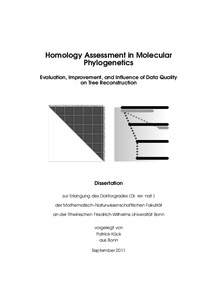Kück, Patrick: Homology Assessment in Molecular Phylogenetics : Evaluation, Improvement, and Influence of Data Quality on Tree Reconstruction. - Bonn, 2012. - Dissertation, Rheinische Friedrich-Wilhelms-Universität Bonn.
Online-Ausgabe in bonndoc: https://nbn-resolving.org/urn:nbn:de:hbz:5n-27474
Online-Ausgabe in bonndoc: https://nbn-resolving.org/urn:nbn:de:hbz:5n-27474
@phdthesis{handle:20.500.11811/5262,
urn: https://nbn-resolving.org/urn:nbn:de:hbz:5n-27474,
author = {{Patrick Kück}},
title = {Homology Assessment in Molecular Phylogenetics : Evaluation, Improvement, and Influence of Data Quality on Tree Reconstruction},
school = {Rheinische Friedrich-Wilhelms-Universität Bonn},
year = 2012,
month = jan,
note = {Considering the final goal of every phylogenetic analysis, the reconstruction of taxon relationships from underlying data, little attention has been paid to the role of alignment accuracy and its impact on tree reconstruction. Alignment masking approaches are methods which detect and remove erroneously aligned sections before tree reconstruction. I describe the effect of two masking methods on alignment quality and tree reconstruction. While masking methods are commonly efficient in detecting ambiguously aligned sequence blocks, all methods more or less lack the ability to detect heterogeneous sequence divergence within sequence alignments. This is a main disadvantage of masking approaches, because undetected heterogeneous sequence divergence can result in a strong bias in tree reconstructions. I give a detailed description of a new developed algorithm and the possibility of tagging branches as an indirect estimation of reliability of a subset of possible splits guided by a topology. The performance of the new algorithm was tested on simulated and empirical data. Considering the tree reconstruction process, the first task is the choice of an appropriate tree reconstruction method. Examining theoretical studies and comparative tests Maximum Likelihood turns out as the first choice for phylogenetic tree reconstructions. I show that the success of Maximum Likelihood depends not only on the degree of alignment quality, but also on the relation of branch length differences of underlying topologies. I tested the robustness of Maximum Likelihood towards different classes of long branch effects in multiple taxon topologies by using simulated fixed data sets under two different 11-taxon trees and a broad range of different branch length conditions with sequence alignments of different length. Some of the most important scripts and pipelines which have been written for the accomplishment of this thesis are also described.},
url = {https://hdl.handle.net/20.500.11811/5262}
}
urn: https://nbn-resolving.org/urn:nbn:de:hbz:5n-27474,
author = {{Patrick Kück}},
title = {Homology Assessment in Molecular Phylogenetics : Evaluation, Improvement, and Influence of Data Quality on Tree Reconstruction},
school = {Rheinische Friedrich-Wilhelms-Universität Bonn},
year = 2012,
month = jan,
note = {Considering the final goal of every phylogenetic analysis, the reconstruction of taxon relationships from underlying data, little attention has been paid to the role of alignment accuracy and its impact on tree reconstruction. Alignment masking approaches are methods which detect and remove erroneously aligned sections before tree reconstruction. I describe the effect of two masking methods on alignment quality and tree reconstruction. While masking methods are commonly efficient in detecting ambiguously aligned sequence blocks, all methods more or less lack the ability to detect heterogeneous sequence divergence within sequence alignments. This is a main disadvantage of masking approaches, because undetected heterogeneous sequence divergence can result in a strong bias in tree reconstructions. I give a detailed description of a new developed algorithm and the possibility of tagging branches as an indirect estimation of reliability of a subset of possible splits guided by a topology. The performance of the new algorithm was tested on simulated and empirical data. Considering the tree reconstruction process, the first task is the choice of an appropriate tree reconstruction method. Examining theoretical studies and comparative tests Maximum Likelihood turns out as the first choice for phylogenetic tree reconstructions. I show that the success of Maximum Likelihood depends not only on the degree of alignment quality, but also on the relation of branch length differences of underlying topologies. I tested the robustness of Maximum Likelihood towards different classes of long branch effects in multiple taxon topologies by using simulated fixed data sets under two different 11-taxon trees and a broad range of different branch length conditions with sequence alignments of different length. Some of the most important scripts and pipelines which have been written for the accomplishment of this thesis are also described.},
url = {https://hdl.handle.net/20.500.11811/5262}
}






